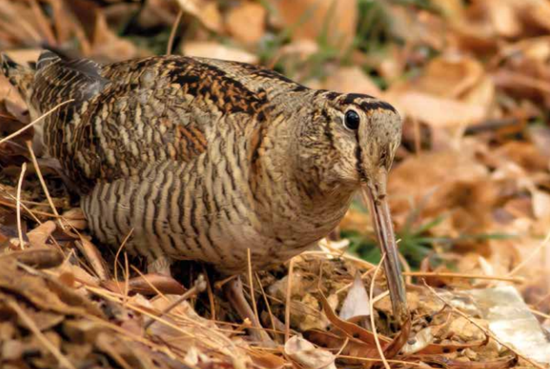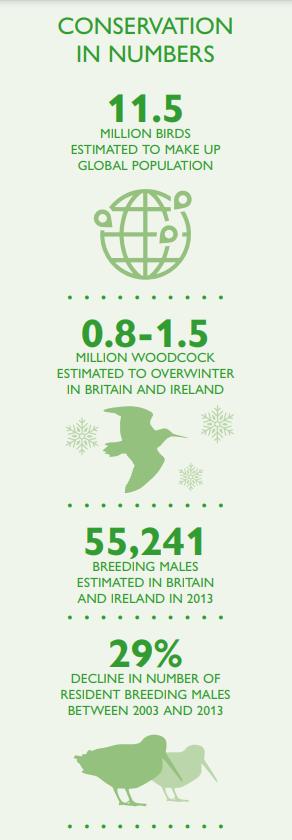
We have recently published Conserving Our Woodcock, a new guide which turns 50 years of GWCT woodcock research into practical guidance on how to provide the varied habitat woodcock require. This blog is taken from the guide, which you can download in full here.
One of the most important things to understand about woodcock in the UK is that there are two distinct groups which, despite being the same species and genetically no different, are generally separate, behave in different ways and are experiencing different fates.
One is resident, breeding here in spring and summer, but staying in winter as well. The other, much larger, group is migratory – breeding elsewhere further north and east and migrating here to overwinter in our warmer climate. The reason this is so important is that the two groups are very different from a conservation perspective.
The resident population is much smaller, has been declining in recent decades, and is therefore on the red list for birds of conservation concern in the UK. As these birds are here all year round, they depend on our countryside and our management throughout their lives – meaning not only that they are vulnerable to our activities but also that we should be able to help support them. The migrant birds, which outnumber residents at least tenfold, also have a remarkable story, but their numbers are stable, and the population is not of conservation concern.
Resident Woodcock
Woodcock are predominantly woodland birds. They breed only in certain parts of the UK, centred on heavily wooded landscapes with large or wellconnected woodland blocks. They are generally more common as a breeding species in Scotland and northern England, but fragmented southern populations remain in areas such as the New Forest and Thetford Forest. In winter, migrant woodcock might be found roosting in practically any wood or copse. Woodcock depend on a diet of earthworms and other invertebrates such as spiders, beetles, and snails, which are obtained by probing the ground with their long, sensitive bills.
Through the winter, adults regularly commute from their daytime roosts in woodland to where they feed at night on open areas of farmland, grassland, and heathland. In the breeding season, females and their broods forage within woodland in areas that offer enough cover to give overhead protection, but which are open enough to easily move through at ground level, such as thickets and bramble patches. Their cryptic plumage helps them remain inconspicuous during the daytime and their large eyes, placed high on the sides of the head, give them near 360° vision for detecting potential predators.
In spring and early summer, male woodcock perform roding displays at dawn and dusk, which consist of a slow, characteristic flight with an accompanying two-part call (a series of three to five low-pitched croaks followed by a high-pitched, nasal whistle). When roding, they fly over woodland, visiting clearings, glades, rides, and woodland edges in order to find a female with which to mate.
Females wait on the ground in these open areas and attract a male’s attention by calling and flashing the white tips of their tails. Once a pair has mated they build a nest in a shallow depression on the ground using leaves and other vegetation, generally laying a clutch of four eggs which hatch 21-25 days later.
The chicks eagerly leave the nest, are able to fly at about 20 days old and fully fledge at 35-40 days. Britain and Ireland support a relatively small resident breeding population of woodcock. Counts of displaying males give us the best information on breeding woodcock numbers, and the most recent population estimate is based on a national survey from 2013, which suggested 55,241 males breeding in Britain.

Recent work by both the British Trust for Ornithology (BTO) and the GWCT show severe declines in the population size and breeding range of our resident woodcock since 1970. Data from the comprehensive Bird Atlas indicate that woodcock were present in 56% fewer 10km squares across Britain and Ireland in 2010 compared to 1970, and this led to them being moved from amber to red status on the UK’s Birds of Conservation Concern evaluation in December 2015.
This downward trend is also supported by the GWCT-BTO national surveys from 2003 and 2013, where 1km squares across Britain containing at least 10ha of woodland were surveyed, and the proportion that held breeding woodcock dropped from 35% to 22%. The British population estimate based on these
surveys fell by 29% from 78,350 breeding males in 2003 to 55,241 in 2013.
Both data sources suggest regional variation in the rate of decline, with losses greatest in the west and south. We do not fully understand what is driving the decline in our breeding woodcock, but we expect there to be multiple factors involved as well as regional differences. Changing climate and changes in the suitability and management of woodland in recent times are likely to be important. We are carrying out further analysis of our datasets to look at patterns in the distribution of breeding woodcock with respect to these factors, as well as others such as predation, deer numbers, recreational disturbance, and shooting.
At present, we cannot rule out shooting as a factor contributing to the decline of our resident woodcock. We recommend that woodcock shooting should not take place before the 1 December, to ensure that migrant woodcock have arrived in sufficient numbers to reduce the impact on resident UK populations. We are gathering information to examine the effect of shooting on breeding woodcock numbers and produce guidance on sustainable harvest rates. Recommendations can be found on page 32 of this document, and more information can be found here.
Migrant Visitors
In winter we see a large influx of migrant woodcock from breeding grounds further north and east. Migrants typically arrive in all months from October to January, but the timing and numbers vary regionally within Britain and Ireland, as well as annually according to the severity of cold weather on the Continent.
It is very difficult to assess the winter population in the UK with accuracy. To make an estimate, numbers have to be derived starting with the relatively reliable number of breeding males in spring. This is used along with the likely number of females that might also be present, and the number of young they may raise in the year to give a possible number of resident birds in winter.
That figure is then scaled up using the proportion of shot birds that are thought to be resident, to give an overall estimate for the total number of woodcock present in the UK in winter. Using this process, and an estimate that around 17% of birds in the UK in winter may be resident, the most recent winter population estimate for woodcock published in the scientific literature is around 1.4 million birds.
However, the authors note the difficulty of estimating woodcock populations, stating that “this estimate of wintering woodcocks is highly approximate, but is thought to be of the right order of magnitude”, and some of the figures used to derive this number have been updated since this calculation was made.